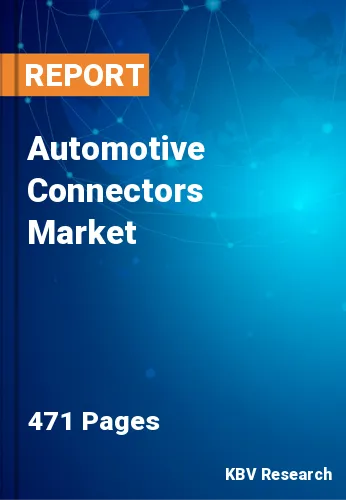The Global Automotive Connectors Market size is expected to reach $15.2 billion by 2030, rising at a market growth of 5.4% CAGR during the forecast period.In the year 2022, the market attained a volume of 1,283.6 million units, experiencing a growth of 3.2% (2019-2022).
Many new safety features, like adaptive front illumination, adaptive cruise control, park assistance, and lane departure warning, have been added to vehicles due to technological advancements. Consequently, the safety and security segment captured $3,858.2 million revenue of the market in 2022. Such functions require many sensors, electronic components, and ECUs. The reliable connectivity between these components is established using a variety of connector types. Additionally, machine learning and V2V communication have boosted vehicle safety.
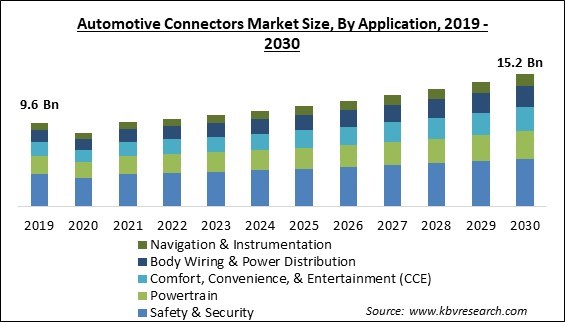
The major strategies followed by the market participants are Acquisitions as the key developmental strategy to keep pace with the changing demands of end users. For instance, In December, 2022, Aptiv acquired Intercable Automotive Solutions to strengthen Aptiv’s position in the field of vehicle architecture systems and enhance the capability to design fully optimized high-voltage architecture solutions. Additionally, In April, 2023, Aptiv PLC took over KUM to expand its range of specialized connectors and cable management solutions and enhance its portfolio.
Based on the Analysis presented in the KBV Cardinal matrix; TE Connectivity Ltd. and Amphenol Corporation are the forerunners in the Market. In July, 2022, TE Connectivity took over Linx Technologies to complement TE’s broad connectivity product offerings, especially in antenna and RF connectors for IoT. Companies such as Kyocera Corporation, Sumitomo Electric Industries, Ltd., Aptiv PLC are some of the key innovators in the Market.
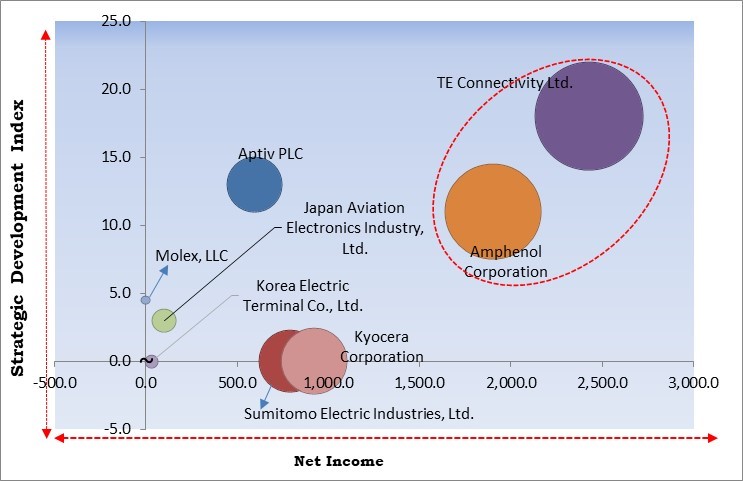
According to the International Energy Agency (IEA), in 2022, 14% of all new automobiles sold were electric, up from less than 5% in 2020 and roughly 9% in 2021. China led the way, representing around 60% of global sales of electric vehicles. China currently accounts for more than half of all-electric vehicles on the road, and the nation has already surpassed its goal for new energy vehicle sales by 2025. Electric and hybrid vehicles require advanced electronic systems to handle power distribution, battery management, and a variety of sensors. These systems require more connectors to ensure effective communication and functioning. Thus, the increased global sales of electric vehicles will support the expansion of the market.
Self-driving cars, also known as autonomous vehicles, are a significant innovation in the automotive industry with enormous growth potential. They catalyze the technological advancement of automobiles. Recent research commissioned by the Department of Transport indicates that the connected and automated vehicle demand in the United Kingdom could be worth £41.7 billion by 2035. The trend toward connected and autonomous vehicles has also facilitated the development of systems that require seamless communication between multiple vehicle components and external networks. This need for connectivity fuels the need for more connectors in vehicles.
Modern vehicles have numerous electronic systems, including infotainment, powertrain control, and safety systems. Each system may require multiple connections for communication and power distribution. Due to this diversity, the wiring harness and connector installation become more difficult. A lack of interoperability can pose safety risks if critical systems cannot communicate effectively or if another misinterprets data from one system. It can be challenging to ensure interoperability between connectors from different manufacturers. The market may be significantly impacted by these issues with complexity and interoperability.
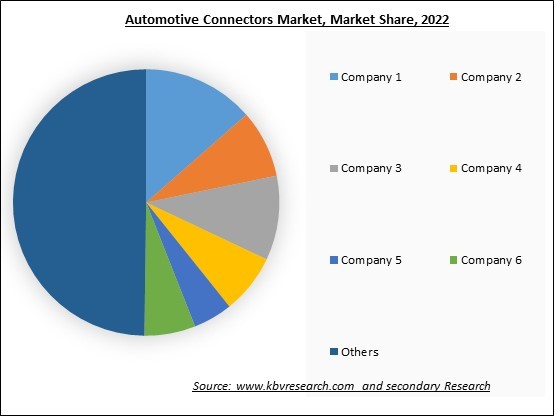
The leading players in the market are competing with diverse innovative offerings to remain competitive in the market. The above illustration shows the percentage of revenue shared by some of the leading companies in the market. The leading players of the market are adopting various strategies in order to cater demand coming from the different industries. The key developmental strategies in the market are Acquisitions.
On the basis of connectivity, the market is fragmented into wire to wire, wire to board, and others. The wire to board segment acquired a substantial revenue share in the market in 2022. A printed circuit board is integrated into the wire-to-board connector to create a circuit by connecting the wires through wire terminals. These are utilized for command transmission from electronic devices to PCB and vice versa.
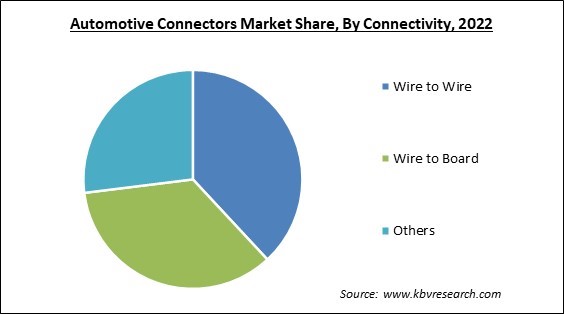
Based on product, the market is segmented into PCB, IC, RF, fiber optic, and others. In 2022, the fiber optic segment covered a considerable revenue share in the market. The growing need for high-speed data transmission has paved the way for fiber optic connectors in the automotive sector. Modern vehicles favor these connectors due to their improved data transfer capabilities and electromagnetic interference (EMI) resistance.
Based on application, the market is categorized into comfort, convenience, & entertainment (CCE), powertrain, safety & security, body wiring & power distribution, and navigation & instrumentation. The body wiring and power distribution segment recorded a remarkable revenue share in the market in 2022. Connectors coordinate wiring and cable connections, lowering the possibility of tangled wires and maintaining a neat and organized vehicle interior. Connectors may include voltage regulators and fuses to safeguard sensitive electronic components against voltage fluctuations and power surges. Due to their function in enabling effective electrical connections, facilitating modular design, assuring safety, offering diagnostic capabilities, and simplifying maintenance, automotive connectors are crucial for vehicle body wiring and power distribution.
By vehicle type, the market is classified into passenger cars and commercial vehicles. In 2022, the passenger cars segment dominated the market with maximum revenue share. Connectors facilitate communication between safety systems, including airbags, anti-lock braking systems (ABS), electronic stability control (ESC), and collision avoidance systems. These systems rely on exchanging precise and timely data to improve passenger safety. Because of the rising sales of passenger vehicles, this segment's market is expanding.
| Report Attribute | Details |
|---|---|
| Market size value in 2022 | USD 10.1 Billion |
| Market size forecast in 2030 | USD 15.2 Billion |
| Base Year | 2022 |
| Historical Period | 2019 to 2021 |
| Forecast Period | 2023 to 2030 |
| Revenue Growth Rate | CAGR of 5.4% from 2023 to 2030 |
| Number of Pages | 471 |
| Number of Table | 933 |
| Quantitative Data | Volume in Million units; revenue in USD Million, and CAGR from 2019 to 2030 |
| Report coverage | Market Trends, Revenue Estimation and Forecast, Segmentation Analysis, Regional and Country Breakdown, Competitive Landscape, Market Share Analysis, Companies Strategic Developments, Company Profiling |
| Segments covered | Product, Connectivity, Vehicle Type, Application, Region |
| Country scope | US, Canada, Mexico, Germany, UK, France, Russia, Spain, Italy, China, Japan, India, South Korea, Singapore, Malaysia, Brazil, Argentina, UAE, Saudi Arabia, South Africa, Nigeria |
| Growth Drivers |
|
| Restraints |
|
Region-wise, the market is analyzed across North America, Europe, Asia Pacific, and LAMEA. In 2022, the Asia Pacific region led the market by generating the highest revenue share. Asian nations, including China, Taiwan, and Japan, are the primary manufacturers of electronic components for both passenger and commercial vehicles. Due to the availability of low-cost labor, improved manufacturing facilities, and convenient access to raw materials, the region is a hub for exporting various types of automotive parts.
Free Valuable Insights: Global Automotive Connectors Market size to reach USD 15.2 Billion by 2030
The market research report covers the analysis of key stake holders of the market. Key companies profiled in the report include TE Connectivity Ltd., Yazaki Corporation, Aptiv PLC, Sumitomo Electric Industries, Ltd., Molex, LLC (Koch Industries, Inc.), Amphenol Corporation, Korea Electric Terminal Co., Ltd., Kyocera Corporation, Rosenberger Hochfrequenztechnik GmbH, and Japan Aviation Electronics Industry, Ltd.
By Application(Volume, Million Units, USD Million, 2019-2030)
By Product(Volume, Million Units, USD Million, 2019-2030)
By Connectivity(Volume, Million Units, USD Million, 2019-2030)
By Vehicle Type(Volume, Million Units, USD Million, 2019-2030)
By Geography(Volume, Million Units, USD Million, 2019-2030)
This Market size is expected to reach $15.2 billion by 2030.
Growing number of electric and hybrid vehicles are driving the Market in coming years, however, Lack of compatibility and complications in interoperability restraints the growth of the Market.
TE Connectivity Ltd., Yazaki Corporation, Aptiv PLC, Sumitomo Electric Industries, Ltd., Molex, LLC (Koch Industries, Inc.), Amphenol Corporation, Korea Electric Terminal Co., Ltd., Kyocera Corporation, Rosenberger Hochfrequenztechnik GmbH, and Japan Aviation Electronics Industry, Ltd.
The Wire-to-Wire segment acquired maximum revenue in the Market by Connectivity in 2022; thereby, achieving a market value of $5.6 billion by 2030.
The PCB segment is leading the Market by Product in 2022; thereby, achieving a market value of $4.3 billion by 2030.
The Asia Pacific region dominated the Market by Region in 2022, and would continue to be a dominant market till 2030; thereby, achieving a market value of $6.0 billion by 2030.
Our team of dedicated experts can provide you with attractive expansion opportunities for your business.
